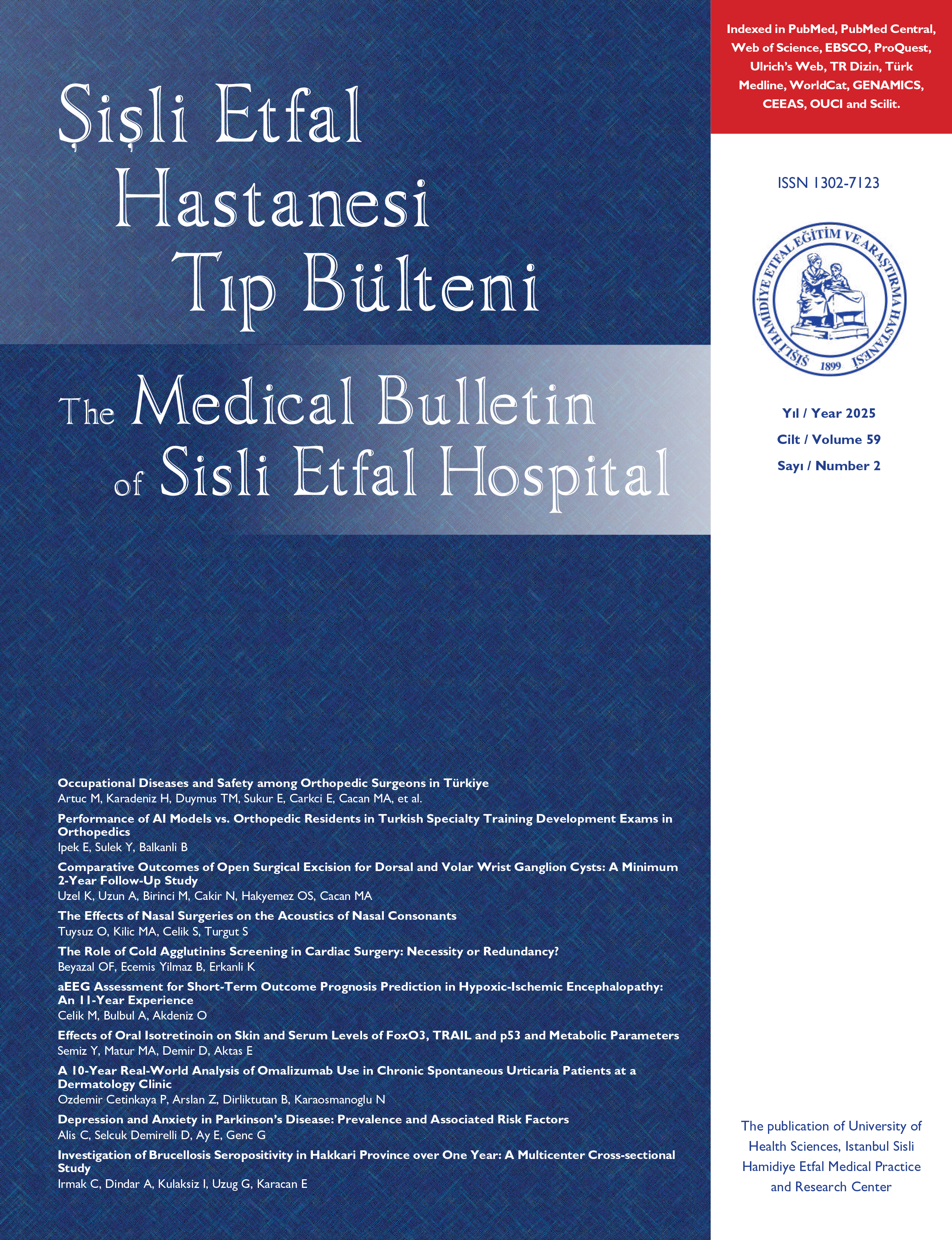
Iyatrojenik Üreter Avülsiyonu Sonrası Böbrek Kaybını Öngörücü Faktörler ve Medikolegal Açıdan Değerlendirilmesi
Ali Ihsan Tasci1, Yavuz Onur Danacioglu1, Fatih Akkas2, Salih Polat3, Yusuf Arikan4, Ekrem Guner1, Feyzi Arda Atar5, Yalcin Buyuk61Türkiye Sağlık Bilimleri Üniversitesi, Bakırköy Dr. Sadi Konuk Eğitim ve Araştırma Hastanesi, Üroloji Anabilim Dalı, İstanbul2Erzurum Bölge Eğitim ve Araştırma Hastanesi, Üroloji Kliniği, Erzurum
3Amasya Eğitim ve Araştırma Hastanesi, Üroloji Kliniği, Amasya
4Muş Devlet Hastanesi, Üroloji Kliniği, Muş
5Başakşehir Çam ve Sakura Şehir Hastanesi, Üroloji Kliniği, İstanbul
6Adli Tıp Kurumu, İstanbul
Amaç: Etkili ve minimal invaziv bir teknik olarak üreteroskopinin bazı potansiyel intraoperatif komplikasyonları vardır. Nadir de olsa üreter avulsiyonu bu komplikasyonlar arasındadır. Bu çalışma literatürde ilk kez üreter avulsiyonunu medikolegal açıdan ele alarak nefrektomiyi öngören faktörleri belirlemeyi amaçlamıştır.
Materyal-Method: Eylül 2004-Nisan 2019 tarihleri arasında Türkiye'de çeşitli hastanelere başvuran ve Adli Tıp Kurumu'nda malpraktis yönünden incelemeye alınan üreteroskopik cerrahi sırasında üreter avulsiyonu gelişen toplam 33 hasta retrospektif olarak değerlendirildi. Üreter avulsiyonu sonrası nefrektomi yapılan hastalar Grup 1, rekonstrüktif cerrahi uygulananlar Grup 2 olarak değerlendirildi.
Bulgular: Hastaların yaş ortalaması 39.5±12.1 yıl idi. On yedi (%51,5) hastada kısmi ve 16'sında (%48,4) tam üreter avulsiyonu vardı. Hastaların 14'üne (%42.4) nefrektomi, 19'una (%57.5) üreter rekonstrüksiyonu uygulandı. Grup 1'deki hastaların Grup 2'ye göre daha fazla proksimal taş ve daha yüksek derecede hidronefroz olduğu belirlendi. Grup 1'deki hastaların %71.4'ünde, Grup 2'deki hastaların ise %31.6'sında tam avulsiyon gelişti. Grup 1'deki hastaların %78,6'sı bir devlet hastanesinde, Grup 2'deki hastaların %63.2'si üçüncü basamak bir sevk hastanesinde tedavi görmüştür. Hidronefroz derecesindeki artış, tam avulsiyon varlığı ve devlet hastanesinde müdahale nefrektomi için bağımsız prediktif faktörler olarak belirlendi.
Sonuç: Bu çalışma üreter avulsiyonunu medikolegal olarak değerlendiren ve nefrektomi için prediktif faktörleri belirleyen literatürdeki en geniş kohorta sahip ilk çalışmadır. Üreter avulsiyonu varlığında her hastanın farklı yöntemlerle tedavi edilmesi gerekse de çalışmamız bu katastrofik komplikasyona ortak bir yaklaşım sağlamayı amaçlamıştır. (SETB-2022-09-207)
Anahtar Kelimeler: Medikolegal perspektif, Nefrektomi, Üreteral avülsiyon, Üreteroskopi
The Predictive Factors of Renal Loss After Iatrogenic Ureteral Avulsion in the Medicolegal Perspective
Ali Ihsan Tasci1, Yavuz Onur Danacioglu1, Fatih Akkas2, Salih Polat3, Yusuf Arikan4, Ekrem Guner1, Feyzi Arda Atar5, Yalcin Buyuk61Department of Urology, University of Medical Sciences Türkiye, Bakırkoy Dr. Sadi Konuk Training and Research Hospital, Istanbul, Türkiye2Department of Urology, Erzurum Regional Training and Research Hospital, Erzurum, Türkiye
3Department of Urology, Amasya Training and Research Hospital, Amasya, Türkiye
4Department of Urology, Mus State Hospital, Mus, Türkiye
5Department of Urology, Basaksehir Cam and Sakura City Hospital, Istanbul, Türkiye
6The Council of Forensic Medicine, Istanbul, Türkiye
Objectives: As an effective and minimally invasive technique, ureteroscopy has some potential intraoperative complications. Ureteral avulsion is among these complications, although rare. This study aimed to determine factors predicting nephrectomy by considering ureteral avulsion from a medicolegal perspective for the 1st time in the literature.
Methods: A total of 33 patients with ureteral avulsion during ureteroscopic surgery, who presented to various hospitals in Turkey between September 2004 and April 2019 and whose cases were being reviewed at the Institution of Forensic Medicine with regard to malpractice, were evaluated retrospectively. The patients who underwent nephrectomy after ureteral avulsion were evaluated as Group 1, and those who underwent reconstructive surgery as Group 2.
Results: The mean age of the patients was 39.5±12.1 years. Seventeen (51.5%) patients had partial and 16 (48.4%) had complete ureteral avulsion. Nephrectomy was performed in 14 (42.4%) patients, and ureteral reconstruction in 19 (57.5%) patients. It was determined that the patients in Group 1 had more proximal stones and a higher degree of hydronephrosis compared to Group 2. Complete avulsion developed in 71.4% of the patients in Group 1 and in 31.6% of those in Group 2. After avulsion, 78.6% of the patients in Group 1 were treated in a state hospital, and 63.2% of those in Group 2 were treated in a tertiary referral hospital. The increase in the degree of hydronephrosis, presence of complete avulsion, and intervention at a state hospital were determined as independent predictive factors for nephrectomy.
Conclusion: This is the first study with the largest cohort in the literature to medicolegally evaluate ureteral avulsion and determine predictive factors for nephrectomy. Although each patient should be treated with different methods in the presence of ureteral avulsion, our study aimed to provide a common approach to this catastrophic complication.
Keywords: Medicolegal perspective, Nephrectomy, Ureteral avulsion, Ureteroscopy
Makale Dili: İngilizce



















